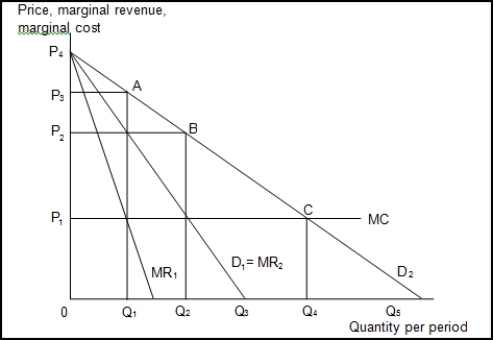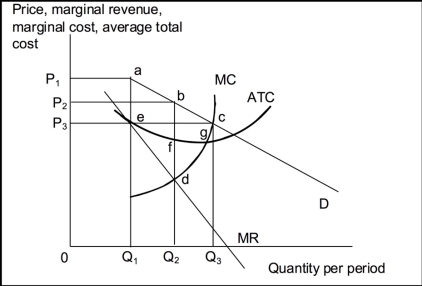A) can be increased by increasing production.
B) can be increased by decreasing production.
C) can be increased by decreasing the price.
D) is maximized only if MC = P.
Correct Answer

verified
Correct Answer
verified
Multiple Choice
Price discrimination is when a firm charges:
A) the same price to all customers.
B) different prices for different goods to different customers.
C) different prices for the same goods to different customers.
D) None of the above are true.
Correct Answer

verified
Correct Answer
verified
Multiple Choice
A restaurant:
A) is a price taker.
B) can set its own price.
C) will lose all of its customers if it raises its prices.
D) is described by both B and C.
Correct Answer

verified
Correct Answer
verified
Multiple Choice
In general, the higher the concentration ratio in an industry, the:
A) greater the ratio of MC to ATC.
B) lower the ratio of MC to ATC.
C) less firms need to pay attention to individual rivals.
D) more firms need to pay attention to individual rivals.
Correct Answer

verified
Correct Answer
verified
True/False
Monopolistic competition is characterized by a single firm producing a product that has no close substitutes.
Correct Answer

verified
Correct Answer
verified
Multiple Choice
A perfectly competitive industry will have a Herfindahl-Hirschman Index equal to about:
A) 1.
B) 100.
C) 1,000.
D) 10,000.
Correct Answer

verified
Correct Answer
verified
Multiple Choice
Due to the existence of a large number of similar, but not identical, substitutes in most communities, the market for chiropractors is best considered:
A) an oligopoly.
B) perfect competition.
C) monopolistic competition.
D) a monopoly.
Correct Answer

verified
Correct Answer
verified
Multiple Choice
Monopolistic competition is an industry characterized by:
A) a product with no close substitutes.
B) many firms facing their own downward-sloping demand curve.
C) a small number of firms.
D) barriers to entry and exit.
Correct Answer

verified
Correct Answer
verified
Multiple Choice
An analytical framework used in the analysis of strategic choices is:
A) the tacit supply curve model.
B) game theory.
C) perfect competition.
D) risk assessment.
Correct Answer

verified
Correct Answer
verified
Multiple Choice
If a firm wants to charge different customers different prices:
A) the firm must be a price taker.
B) firm must be in perfect competition.
C) firm must be a price setter.
D) A and B must be true.
Correct Answer

verified
Correct Answer
verified
Multiple Choice
Use the following to answer question(s) : Monopoly Through Collusion
 -(Exhibit: Monopoly Through Collusion) For this question assume that the duopoly industry illustrated in the exhibit produces a perishable good.If each firm acted on the belief that it faced demand curve D₂ and acted without consideration of the other firm's behavior, the market price would likely end up being _______ and the combined economic profits of the firms would be _______ .
-(Exhibit: Monopoly Through Collusion) For this question assume that the duopoly industry illustrated in the exhibit produces a perishable good.If each firm acted on the belief that it faced demand curve D₂ and acted without consideration of the other firm's behavior, the market price would likely end up being _______ and the combined economic profits of the firms would be _______ .
A) P₁; given by the area of the rectangle bounded by 0P₁CQ₄
B) P₁; zero
C) P₃; given by the area of the rectangle bounded by 0P₃AQ₁
D) P₂; given by the area of the rectangle bounded by P₁P₂BG
Correct Answer

verified
Correct Answer
verified
Multiple Choice
Use the following to answer question(s) : The Restaurant Model
 -(Exhibit: The Restaurant Market) The exhibit shows curves facing a typical restaurant in a community.Assume that the market is characterized by many firms, differentiated products, easy entry and easy exit.If the restaurant shown here is typical of others in the community, then in the long run, we would expect to observe:
-(Exhibit: The Restaurant Market) The exhibit shows curves facing a typical restaurant in a community.Assume that the market is characterized by many firms, differentiated products, easy entry and easy exit.If the restaurant shown here is typical of others in the community, then in the long run, we would expect to observe:
A) restaurants leaving the market.
B) new restaurants entering the market.
C) neither entry nor exit.
D) There is not enough information given to answer the question.
Correct Answer

verified
Correct Answer
verified
True/False
A cartel is an example of secretive, informal collusive agreements.
Correct Answer

verified
Correct Answer
verified
Multiple Choice
Use the following for questions 43-51.
Exhibit: Firms in Monopolistic Competition
 -(Exhibit: Firms in Monopolistic Competition) In Panel (a) , the profit-maximizing quantity of output is generated by the intersection at point:
-(Exhibit: Firms in Monopolistic Competition) In Panel (a) , the profit-maximizing quantity of output is generated by the intersection at point:
A) K.
B) M.
C) N.
D) O.
Correct Answer

verified
Correct Answer
verified
Multiple Choice
Oligopoly is a market structure characterized by:
A) independence in decisionmaking.
B) a horizontal demand curve.
C) a small number of interdependent firms.
D) relatively easy entry and exit.
Correct Answer

verified
Correct Answer
verified
True/False
The HHI is a measure of concentration of industry.
Correct Answer

verified
Correct Answer
verified
Multiple Choice
The practice of charging different prices to different customers for the same good or service even though the cost of supplying those customers is the same is:
A) privatization.
B) monopolization.
C) output competition.
D) price discrimination.
Correct Answer

verified
Correct Answer
verified
Multiple Choice
On the spectrum of market structures, monopolistic competition lies:
A) at the same location as monopoly.
B) at the same location as perfect competition.
C) between perfect competition and monopoly.
D) to the left of both perfect competition and monopoly.
Correct Answer

verified
Correct Answer
verified
True/False
In monopolistic competition, consumers would be better off if output were expanded.
Correct Answer

verified
Correct Answer
verified
Multiple Choice
Use the following to answer question(s) : Monopoly Through Collusion
 -(Exhibit: Monopoly Through Collusion) The exhibit illustrates the situation in an industry that consists of two firms facing identical demand curves; the demand curve for each firm is D₁.If the firms collude and agree to share the market demand equally, then each firm will act as if its demand curve is given by:
-(Exhibit: Monopoly Through Collusion) The exhibit illustrates the situation in an industry that consists of two firms facing identical demand curves; the demand curve for each firm is D₁.If the firms collude and agree to share the market demand equally, then each firm will act as if its demand curve is given by:
A) D₁.
B) D₂.
C) MR₁.
D) 2 x D₁.
Correct Answer

verified
Correct Answer
verified
Showing 141 - 160 of 237
Related Exams